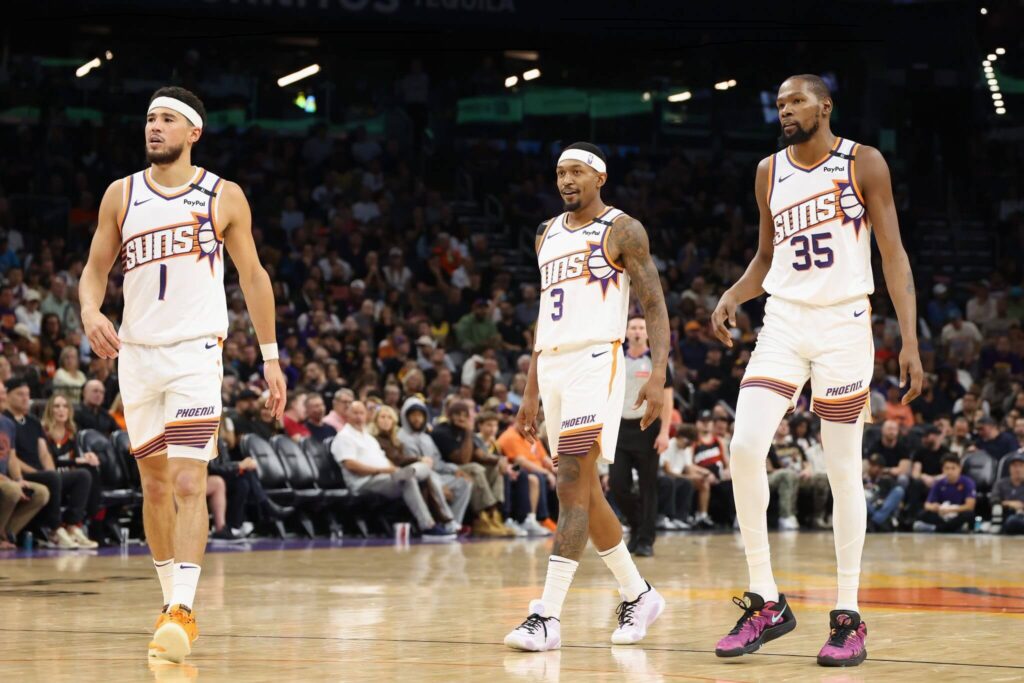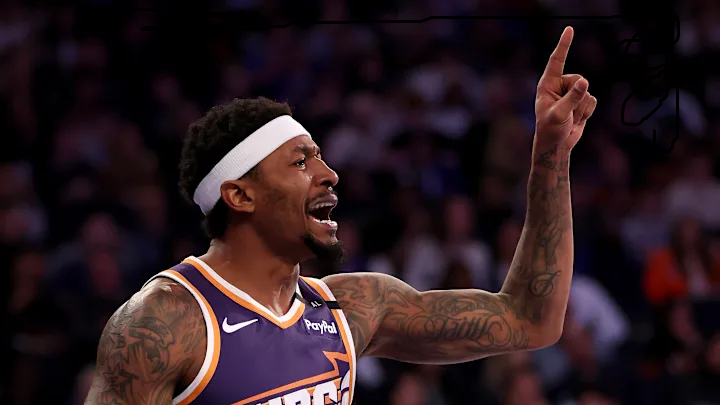The Suns’ deal for Bradley Beal becomes one of the franchise’s worst as he departs.
PHOENIX— The timing was concerning. Before entering PHX Arena for the Phoenix Suns’ last home game of a disappointing season, which was a meaningless matchup against the San Antonio Spurs, supporters were given a little card.
Fan Appreciation Moment
Use this voucher to redeem your Bradley Beal Bobblehead.
The Plaza outside the Pavilion entrance is where you can pick up right after the last buzzer sounds for 30 minutes after the game.
The pairing of a Beal bobblehead and fan appreciation made people laugh that evening. Beal hadn’t been the most well-liked man in the city since the trade deadline. or the most beneficial.
Beal’s time came to an end on Wednesday after he and the Suns agreed to a buyout of a contract that could not be transferred. This is a picture of how Beal may be remembered in the desert. Over the next two years, according to The Athletic’s Fred Katz, Beal will repay $13.8 million of the $110.8 million he was previously owed by the Suns. By spreading the remaining $97 million across five years, the Suns will have a dead cap hit of $19.4 million that will remain on Phoenix’s books for every season through 2029-30.
The advantages for both parties are obvious. The Suns are able to move on from a disappointing period, freeing themselves from the limitations of the first and second tax aprons which aid in the development of a competitive team. Beal is a free agent, but he can join a Western Conference rival for a far lower price. Once he clears waivers, he is anticipated to sign a two-year, $11 million agreement with the Los Angeles Clippers.

The conclusion is not what one would anticipate.
In the summer of 2023, the Suns signed Beal in a trade that included Chris Paul, in the hopes that he would be an additional scorer alongside Kevin Durant and Devin Booker to accelerate the team’s quest for a title. During his introductory news conference, Beal’s first inquiry addressed playing meaningful postseason games, which he hadn’t done much during his 11 seasons with the Washington Wizards.
Reality took a different course. The Suns’ “Big Three” failed to compete in two seasons, and they never even won a playoff match. They had the league’s priciest roster last year, but they were unable to advance to the Play-In Tournament, finished with 36-46 record. Mat Ishbia, the enraged owner, pledged reforms.
Locals frequently cite Phoenix’s failure to re-sign Joe Johnson in 2005, a crucial component of a formidable Western Conference championship contender, as one of the worst choices in Suns history, which may have cost the Suns a title during Steve Nash 7 Seconds or Less era. Later, this was listed by Robert Sarver, the previous owner, as one of his biggest regrets.
It is on par with the Beal purchase. For what it symbolizes, not for what it represents. A squad that is top-heavy and lacks chemistry and tenacity. A costly failure.
Not all of this is Beal’s fault. The veteran guard’s current knowledge was all available when the Suns acquired him via trade. The excessive contract. The prohibition on trades. The overlap of talents with Booker. The history of the injury. Beal’s scoring talent was the positive; he was a three-time All-Star who was two years away from averaging 30 points per game for the second consecutive season. To be sure, the prospect of Durant, Booker, and Beal is alluring. (Full disclosure, the author was intrigued.) Yet, someone in the Suns ought to have considered, “Hey, we may have a problem if this doesn’t go as well as we expect.”

It did not. And they did.
Beal deserves praise for working hard to adapt his style to meet Phoenix’s needs. He occasionally played well. When the Suns were in need of a point guard, he managed the offense. He guarded the opposing team’s top perimeter scorer. He played off the bench for a period last season. However, his role was not the only issue.
The Suns’ choices for improvement last season were restricted by a pay restriction that prohibited high-spending clubs from making transactions. Beal was an obvious trade prospect, but no one was particularly interested in a frequently wounded guard who owe so much money. There were repercussions. The Suns first attempted to switch to Durant at the deadline, but they were unable to get rid of Beal. Then, in July, Phoenix agreed to a transaction with the Houston Rockets that sent Durant away in exchange for a package that featured athletic guard Jalen Green, defensive ace Dillon Brooks, and the tenth selection in the NBA Draft in June, which the Suns used to select Duke center Khaman Maluach.
Beal averaged 17 points during his last season, with a shooting percentage of 49.7% from the field and 38.6% from three. He may have been determined to demonstrate that he deserved a place in the starting five, as he provided a spark. But the image of Beal wearing street attire and sitting at the end of the Phoenix bench will always be with us. He suffered misfortune every time he started to get into a groove. The hamstring, calf. A large toe. During his time in the desert, Beal missed 35.4% of Phoenix’s regular-season contests.
The audience grew weary. Additionally, when asked about possible trades, they ignored Beal’s reaction, reiterating to journalists that Beal had the upper hand due to the no-trade clause. Even though it appeared selfish, it wasn’t always the case. Although Beal was eccentric—notably being called out for tying his shoes during a game—he was nonetheless a professional. In a recent interview, Phoenix general manager Brian Gregory declined to speculate about a potential acquisition, but he reaffirmed his admiration for Beal.

His output never lived up to his compensation.
The Suns are not yet out of the woods. The $19.4 million Beal purchase over five years may be problematic in their efforts to create around Booker, the sole survivor of the “Big Three”, if they extend it. However, considering the circumstances, this was the best course of action. It would have reminded us of past errors if Beal had stayed for two more years. Time to advance.



























